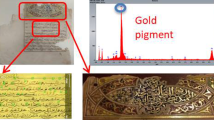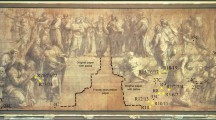Abstract
Various modern instrumental techniques for surface analysis were applied for the non-destructive physico-chemical examination of works of art. As samples, pieces of ancient manuscripts endangered by iron-gall ink corrosion were used. Surface characterisation of the morphology of the cellulose fibres within corroded and non-corroded parts of the manuscript performed by scanning electron microscopy (SEM) showed seriously damaged cellulose fibres in the written parts. The elemental composition of selected parts of the manuscript was determined by energy dispersive X-ray fluorescence analysis (EDX). A more detailed study of the paper surface was then performed by electron probe microanalysis (EPMA). This technique yields the morphological characteristics of the surface as well as element distribution maps over the written area of the investigated manuscript.
Similar content being viewed by others
Author information
Authors and Affiliations
Additional information
Received: 21 November 2000 / Revised: 18 January 2001 / Accepted: 23 January 2001
Rights and permissions
About this article
Cite this article
Wagner, B., Bulska, E., Hulanicki, A. et al. Topochemical investigation of ancient manuscripts. Fresenius J Anal Chem 369, 674–679 (2001). https://doi.org/10.1007/s002160100750
Issue Date:
DOI: https://doi.org/10.1007/s002160100750




